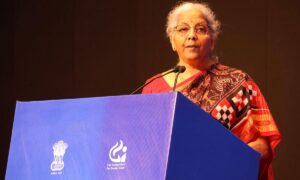![As agricultural productivity flounders in the Sundarbans, unskilled labour is all the residents have to sell [image by: Mike Prince]](https://impactnews.in/wp-content/uploads/2018/03/Unloading-bricks-Mike-Prince-1020x612-e1520664048501.jpg)
As agricultural productivity flounders in the Sundarbans, unskilled labour is all the residents have to sell [image by: Mike Prince]
In India, 55% of male migrants send remittances to support households have left behind. Does that mean migration by poor farmers is a blessing? The answer is complicated – farm productivity can be negatively affected by outmigration of labour, but remittances may help households to overcome constraints on production and to hire fresh labour. At the same time remittances may starkly increase inequality in communities, creating fresh tensions.
These factors can be seen clearly in the Sundarbans, the world’s largest mangrove forest – an area already beset by poverty and now suffering saline water inundation as the sea level rises due to climate change. Around 34% of the 4.6 million people residing in different islands of the Indian Sundarbans Delta (ISD) live in extreme poverty and 75% of families there have at least one member working in other states of India.
We examined this link through a study of three islands that face the Bay of Bengal along the western boundary of the ISD – Sagar, Ghoramara, and Mousuni. All three islands are affected by coastal erosion and cyclonic surge causing saline water inundation, while there is also an over-exploitation of resources. The consequent loss in agricultural productivity imposes severe challenges to the farming communities of these islands.
The different status of different islands
Sagar is the largest island in the ISD, with a population of 206,844 according to the 2011 Census. There are 42 villages on Sagar Island. Ghoramara Island, located to the north of Sagar, covers an area of 4.8 square kilometres with a population of 5,193. It had eight villages, of which four have disappeared under the waters. Mousuni is a 24 square kilometre island and had 22,073 people when the 2011 Census was conducted. Most residents in these islands are engaged in farming, fishing, tourism and transport services, with a few in business and industry. It is a single-crop paddy growing area.
85% of the land in Sagar is farmland, compared to 17% in Mousuni and 1.2% in Ghoramara. Unsurprisingly, the largest percentage of out-migration is from Ghoramara, so much so that even some available land lies fallow and neglected, which makes it more vulnerable to saline water inundation because no one repairs the embankments. The rate of erosion estimated from 1990 to 2015 was 0.2 square kilometres per year in Sagar, 0.02 square kilometres per year in Ghoramara and 0.08 square kilometres per year in Mousuni islands.
Salinity, excessive use of chemical fertilisers, and an irrigation deficit have together ensured a decline in farm productivity in these islands, a phenomenon confirmed in the District Statistical Handbook, Government of West Bengal, from 2000-01 to 2011-12. There has been a steady fall in production after 2009. Cyclone Aila hit this region in May 2009. As a consequence, rice production was reduced to 32-40 quintal (a quintal is 100 kilogrammes) per 1.6 hectares (0.016 square kilometres) from 64-80 quintal per 1.6 hectares.
Most farmers in these islands have little access to wholesale markets and end up selling their produce to middlemen at lower prices. All this put together forces farmers to look for other livelihood options, particularly during non-monsoon months. Many have had to sell their farms. Education levels are low, so chances of jobs in the formal sector are limited. Most end up working as daily labourers.
![As climate change impacts reduce agricultural productivity, poverty rises in the Sundarbans [image by: Rosa Maria Vidal]](https://impactnews.in/wp-content/uploads/2018/03/Rosa-Maria-Vidal-e1520664337221.jpg)
As climate change impacts reduce agricultural productivity, poverty rises in the Sundarbans [image by: Rosa Maria Vidal]
A steadily denuding resource base is making it difficult for the people in this region to sustain themselves through the year. At the same time higher income opportunities exist in other places like the Indian states of Gujarat and Chennai. The high degree of occupational dependence on agriculture and its rapidly declining income share is an indication of a higher incidence of poverty in these islands. Literature suggests that migration can have a positive effect on livelihoods through remittances. Remittances may also contribute increasing inequality in income between households with and without migrant labourers.
To test this hypothesis, one to one interviews were conducted between May 2012 and October 2013 with members of 783 households from 27 villages in the three islands.
Questions were also asked to get the perception of local farmers on agricultural productivity losses, poverty, and out-migration. Respondents were also asked if they felt the impact of climate change. They mostly responded in the affirmative to this question, mentioning temperature increases and shifts in rainfall as consequences.
The study confirmed that erosion, inundation, and cyclones have significant association with agricultural productivity decreases. In our sample, 41% of all households reported productivity losses. It also confirmed that agricultural land loss as a consequence of erosion generates threats to the farmer communities of these islands. Saline water inundation – saline water intrusion due to extreme high tide overtopping or embankment failure – was seen to have the greatest adverse impact on productivity. The study found significant impact of cyclonic storms on agricultural productivity. The odds of suffering from productivity loss was found to be higher on Mousuni when compared with the other two islands. This can be explained by the differential developmental levels of these three islands, in particular, the considerably better infrastructure in Sagar Island.
Not all suffer equally
Low productivity accelerates poverty in farmer communities. In addition, institutional shortcomings and limited governance such as the absence of proper crop markets and cooperatives (and consequently, the presence of middlemen) do not allow farmers to get better prices for their produce. Not all suffer equally. Literate farmers are likely to suffer least from productivity change as they may have better access to weather forecasts and may use modern farming techniques.
Less profit from agriculture often compels farmers to sell their land and migrate to other places for livelihoods. Low agricultural productivity does not enable sustenance of farming families, triggering migration in the hope of generating alternative livelihoods. Decrease in agricultural production is significantly more likely to accelerate the probability of migration.
Land ownership may influence the decision of out-migration, it was found. Also, the migration pattern is not the same in all the islands. Sagar Island is the most developed and experiences the least migration due to productivity decreases. This study also confirmed that non-farm workers are likely to migrate more than farmers, which may be attributed to the higher wage differences in the non-farm sector between rural and urban areas.
The study found that an average of 30% of people among the surveyed population migrates. Families with members working outside benefit from remittances. Other residents are lured by the changed lifestyles of the migrants and follow them, driven by poverty. Households with at least one member who has migrated outside are significantly more likely to be richer than other households. There is a significant level of inequality in income distribution in the area, which may be attributed to remittances.
Policy recommendations
From this study, we found causal factors behind productivity change, poverty, and migration. In this context, strengthening links between these key variables should be the main focus for policy strategies. Right now, few policy recommendations are provided for improving system sustainability, accounting for the complex socio-ecological system of the Sundarbans.
First, agricultural training with special emphasis on climate resilient agricultural techniques is needed to help households cope with saline water inundation. Appropriate, ecosystem-specific, cost-effective technologies – including restoration of traditional seeds for farming – can be introduced to the farmers. Crop diversification could be a measure to reduce crop failure and productivity losses. Horticulture practices could enhance the household’s income. Crop insurance with full subsidies might be an effective measure to protect society from the financial vulnerability in case of natural hazards. Establishment of markets via the internet may be an effective option for better economic returns. Establishing block level markets and flexible marketing strategies may also enhance profitability and ensure more involvement in the agricultural sector. The negative impact of erosion and sea water inundation could be limited through the construction of stable embankments along the sea and tidal rivers, and regular repair and maintenance of existing embankments.
Second, reduction of poverty may help lower out-migration. A holistic, dynamic, people-oriented and sustainable framework focusing on poverty eradication is necessary, with special attention to remote areas that are least developed. New self-help groups can be set up or existing ones strengthened through training programmes – preferably at the block level – to reduce poverty through income generation. Government employment schemes such as Mahatma Gandhi National Rural Employment Guarantee Scheme (MGNREGS) and Swarnajayanti Gram Swarojgar Yojana (SGSY) may also be effective measures. The inclusion of more below-poverty-line (BPL) families to Antyodaya Anna Yojana (scheme for poorest of the poor) can be an effective measure.
Third, migration has been considered as an adaptation factor to overcome poverty, and/or limited access to resources and livelihood opportunities. But unplanned migration is producing a huge number of unskilled labour. This study found that migrants are mostly becoming engaged in informal sectors as unskilled workers such as daily labour and construction labour. The absence of fixed wage structure and regulations at informal sector leads to exploitation and insecurity among workers. Also, extensive out-migration is creating scarcity of agricultural labour in these islands, and the situation is acute in Ghoramara. The necessity of skill development amongst the young to secure decent jobs or support entrepreneurship is strongly felt. The potential of ecotourism and religious tourism can also be explored. Effective weather prediction and forecasting, along with the use of latest scientific and technological intervention, may strengthen agriculture, forestry and fishing as profit-making livelihoods.
Rituparna Hajra teaches at the Department of Geography, Sarsuna College, Kolkata, India, and Tuhin Ghosh teaches at the School of Oceanographic Studies, Jadavpur University, Kolkata, India.
This article was originally published in the Third Pole. To read the original article click here :


















